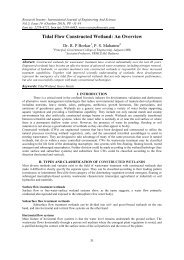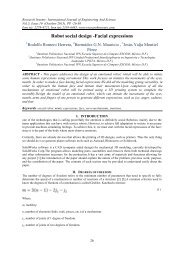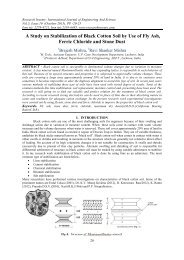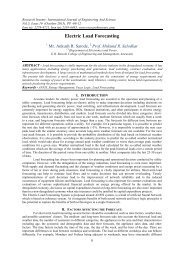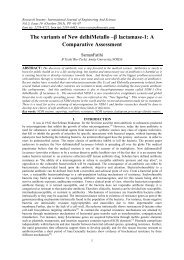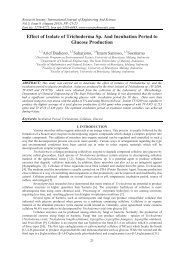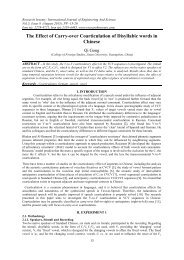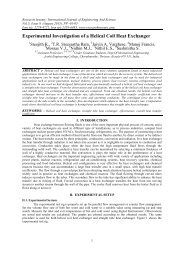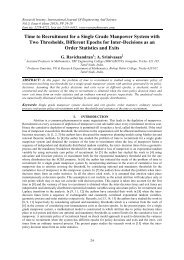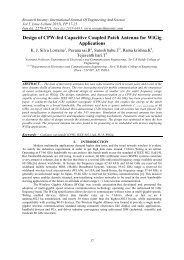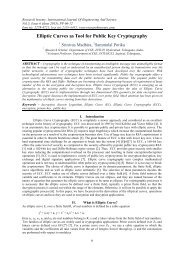Endorsement of Technology in Mathematics: Secondary Educational Perspective
Create successful ePaper yourself
Turn your PDF publications into a flip-book with our unique Google optimized e-Paper software.
Research Inventy: International Journal Of Eng<strong>in</strong>eer<strong>in</strong>g And Science<br />
Vol.5, Issue 6 (June 2015), PP 13-16<br />
Issn (e): 2278-4721, Issn (p):2319-6483, www.research<strong>in</strong>venty.com<br />
<strong>Endorsement</strong> <strong>of</strong> <strong>Technology</strong> <strong>in</strong> <strong>Mathematics</strong>: <strong>Secondary</strong><br />
<strong>Educational</strong> <strong>Perspective</strong><br />
Dr. Babitha Ann Joseph,<br />
Assistant pr<strong>of</strong>essor, Aligarh Muslim University , Malappuram Centre<br />
Abstract : This theoretical paper <strong>in</strong>tends to explore the endorsement <strong>of</strong> technology <strong>in</strong> the teach<strong>in</strong>g and learn<strong>in</strong>g<br />
<strong>of</strong> mathematics <strong>in</strong> secondary educational perspective. The secondary education scenario constitutes the most<br />
remarkable constituent <strong>in</strong> the educational life <strong>of</strong> each person. <strong>Mathematics</strong> is an exquisite factor which helps <strong>in</strong><br />
the enhancement <strong>of</strong> learners <strong>in</strong>tellectual pr<strong>of</strong>iciencies <strong>in</strong> <strong>in</strong>tuitive th<strong>in</strong>k<strong>in</strong>g, logical reason<strong>in</strong>g, problem solv<strong>in</strong>g,<br />
spacial visualization and abstract th<strong>in</strong>k<strong>in</strong>g. Through this paper the <strong>in</strong>vestigator br<strong>in</strong>g about the significance,<br />
recent trends and implications <strong>of</strong> us<strong>in</strong>g technology <strong>in</strong> the teach<strong>in</strong>g and learn<strong>in</strong>g <strong>of</strong> mathematics. This paper will<br />
be beneficial for the learners and teachers <strong>in</strong> their mathematics educational endeavors.<br />
I. Introduction<br />
<strong>Mathematics</strong> is an <strong>in</strong>evitable part <strong>in</strong> the general education scenario. The abstract and hypothetical<br />
nature <strong>of</strong> <strong>Mathematics</strong> <strong>of</strong>ten causes disregard and lethargy among the learners. The teach<strong>in</strong>g and learn<strong>in</strong>g <strong>of</strong> the<br />
discipl<strong>in</strong>e <strong>in</strong>volves tedious efforts like memorizations, calculations, explorations, f<strong>in</strong>d<strong>in</strong>g solutions, connect<strong>in</strong>g<br />
different ideas etc. it has been always a big concern <strong>of</strong> teachers and educators <strong>in</strong> enhanc<strong>in</strong>g the competencies <strong>in</strong><br />
mathematics. In the Pr<strong>in</strong>ciples and Standards <strong>of</strong> School <strong>Mathematics</strong> the National Council <strong>of</strong> Teachers <strong>of</strong><br />
<strong>Mathematics</strong> (NCTM) identified the "<strong>Technology</strong> Pr<strong>in</strong>ciple" as one <strong>of</strong> six pr<strong>in</strong>ciples <strong>of</strong> high quality mathematics<br />
education (NCTM, 2000). This pr<strong>in</strong>ciple states: "<strong>Technology</strong> is essential <strong>in</strong> teach<strong>in</strong>g and learn<strong>in</strong>g mathematics;<br />
it <strong>in</strong>fluences the mathematics that is taught and enhances students' learn<strong>in</strong>g" (p. 24).<br />
The use <strong>of</strong> technology <strong>in</strong> education is <strong>in</strong> accordance with the key theme and objective <strong>of</strong> 21 st century<br />
learn<strong>in</strong>g, i.e., student centered learn<strong>in</strong>g. <strong>Technology</strong> enhances self learn<strong>in</strong>g capabilities and creative faculties <strong>of</strong><br />
the learners. The use <strong>of</strong> technology <strong>in</strong> mathematics has a long history start<strong>in</strong>g from the use <strong>of</strong> abacus.<br />
<strong>Technology</strong> can change the nature <strong>of</strong> school mathematics by engag<strong>in</strong>g students <strong>in</strong> more active mathematical<br />
practices such as experiment<strong>in</strong>g, <strong>in</strong>vestigat<strong>in</strong>g and problem solv<strong>in</strong>g that br<strong>in</strong>g depth to their learn<strong>in</strong>g and<br />
encourage them to ask questions rather than only look<strong>in</strong>g for answers (Farrell, 1996; Makar & Confrey, 2006).<br />
Olive and Makar (2010) argue that mathematical knowledge and mathematical practices are<br />
<strong>in</strong>extricably l<strong>in</strong>ked, and that this relation can be strengthened by mak<strong>in</strong>g use <strong>of</strong> technologies. They developed an<br />
adaptation <strong>of</strong> Ste<strong>in</strong>br<strong>in</strong>g’s (2005) ‘didactic triangle’ that <strong>in</strong> its orig<strong>in</strong>al form represents the learn<strong>in</strong>g ecology as<br />
<strong>in</strong>teractions between student, teacher and mathematical knowledge. Introduc<strong>in</strong>g technology <strong>in</strong>to this system<br />
transforms the learn<strong>in</strong>g ecology so that the triangle becomes a tetrahedron, with the four vertices <strong>of</strong> student,<br />
teacher, task and technology creat<strong>in</strong>g ‘a space with<strong>in</strong> which new mathematical knowledge and practices may<br />
emerge’ (p. 168). In this theoretical paper the <strong>in</strong>vestigator <strong>in</strong>tends to explore the endorsement <strong>of</strong> technology <strong>in</strong><br />
the teach<strong>in</strong>g and learn<strong>in</strong>g <strong>of</strong> mathematics with reference to secondary education.<br />
II. Computer Assisted Instruction <strong>in</strong> <strong>Mathematics</strong><br />
For mak<strong>in</strong>g the discipl<strong>in</strong>e, mathematics impressionable to the student’s teacher should be well versed with<br />
different methodologies <strong>of</strong> teach<strong>in</strong>g mathematics. Computer Assisted Instruction is one <strong>of</strong> the most effective<br />
auto <strong>in</strong>structional methods which can be <strong>in</strong>corporated <strong>in</strong> the teach<strong>in</strong>g methodology <strong>of</strong> mathematics. Computers<br />
can provide ample opportunities for the students <strong>in</strong> mean<strong>in</strong>gful learn<strong>in</strong>g <strong>of</strong> the subject s<strong>in</strong>ce computers can act<br />
accord<strong>in</strong>g to the imag<strong>in</strong>ation <strong>of</strong> the students. When compared to the traditional method <strong>of</strong> teach<strong>in</strong>g mathematics,<br />
Computer Assisted Instruction can br<strong>in</strong>g enormous changes <strong>in</strong> the teach<strong>in</strong>g and learn<strong>in</strong>g environments. The<br />
<strong>in</strong>vestigators have po<strong>in</strong>ted out the factors <strong>in</strong> the follow<strong>in</strong>g tabular form.<br />
13
<strong>Endorsement</strong> Of <strong>Technology</strong> In <strong>Mathematics</strong>…<br />
Conventional Method<br />
Computer Assisted Instruction<br />
Teacher centered<br />
Limited number <strong>of</strong> learn<strong>in</strong>g resources’<br />
Time and place constra<strong>in</strong>ts<br />
Content may not be arranged <strong>in</strong> an<br />
<strong>in</strong>terest<strong>in</strong>g and mean<strong>in</strong>g full way which<br />
can cause self learn<strong>in</strong>g<br />
There are a lot <strong>of</strong> chances for rote<br />
memorization<br />
Chances for boredom and reluctant from<br />
learn<strong>in</strong>g<br />
Student centered<br />
Diversified learn<strong>in</strong>g resources’<br />
Able to learn at their own pace and place<br />
Mean<strong>in</strong>gfully arranged content which creates a<br />
positive attitude towards the learn<strong>in</strong>g <strong>of</strong><br />
mathematics<br />
Duration <strong>of</strong> active learn<strong>in</strong>g and distributed<br />
practice <strong>of</strong> academic content has <strong>in</strong>fluenced the<br />
level <strong>of</strong> academic retention (Belfiore, Sk<strong>in</strong>ner &<br />
Ferk<strong>in</strong>s, 1995).<br />
Rema<strong>in</strong> motivated throughout the learn<strong>in</strong>g process<br />
III. Employment <strong>of</strong> calculators and converters<br />
The present learner needs a methodical excellence <strong>in</strong> mathematical knowledge for transform<strong>in</strong>g <strong>in</strong>to a<br />
technologically oriented workforce <strong>in</strong> this era. <strong>Technology</strong>, <strong>in</strong> particular computer and calculator technology, is<br />
seen as a means <strong>of</strong> provid<strong>in</strong>g the tools needed to facilitate the transition, while serv<strong>in</strong>g as a catalyst for further<br />
change <strong>in</strong> high school mathematics education (Owens & Waxman, 1995). Calculators and converters form an<br />
<strong>in</strong>tegral part <strong>of</strong> the teach<strong>in</strong>g and learn<strong>in</strong>g process <strong>of</strong> the discipl<strong>in</strong>e. It is not only stressful but also a waste <strong>of</strong> time<br />
to memorize the formulas and for do<strong>in</strong>g calculations. The usage <strong>of</strong> calculators and converters is not a substitute<br />
but it enhances the pr<strong>of</strong>iciency <strong>in</strong> computations. It also improves the <strong>in</strong>volvement <strong>of</strong> students <strong>in</strong> their learn<strong>in</strong>g<br />
endeavors.<br />
In primary classrooms the practice <strong>of</strong> us<strong>in</strong>g calculators and computers is not judicious, s<strong>in</strong>ce learners<br />
should become well versed and enriched with numerals. After the atta<strong>in</strong>ment <strong>of</strong> conceptualization and fluency <strong>in</strong><br />
deal<strong>in</strong>g with numbers, it will be advantageous for the learners to use technology <strong>in</strong> construct<strong>in</strong>g new<br />
knowledge. The <strong>in</strong>vestigator showcases the catalytic role <strong>of</strong> calculators and converters <strong>in</strong> the form <strong>of</strong> TIP us<strong>in</strong>g<br />
the Figure 1 presented below.<br />
Time<br />
Sav<strong>in</strong>g<br />
Inspir<strong>in</strong>g<br />
Prosper<strong>in</strong>g<br />
Figure 1: Calculators & Converters as<br />
Catalyst <strong>in</strong> Math Learn<strong>in</strong>g<br />
14
<strong>Endorsement</strong> Of <strong>Technology</strong> In <strong>Mathematics</strong>…<br />
IV. Handheld Graph<strong>in</strong>g <strong>Technology</strong><br />
Handheld Graph<strong>in</strong>g <strong>Technology</strong> is one <strong>of</strong> the most recent <strong>in</strong>novations <strong>in</strong> the field <strong>of</strong> educational<br />
technology. It provides a variety <strong>of</strong> learn<strong>in</strong>g tools which helps the learners to visualize and develop a better<br />
perception <strong>in</strong> mathematics. The first Handheld Graph<strong>in</strong>g <strong>Technology</strong> was <strong>in</strong>troduced by Casio (1985) <strong>in</strong> Japan.<br />
In a large survey from Michigan State University (Burril, 2002), one <strong>of</strong> the central f<strong>in</strong>d<strong>in</strong>gs is the follow<strong>in</strong>g:<br />
Given support<strong>in</strong>g conditions, the evidence <strong>in</strong>dicates that handheld graph<strong>in</strong>g technology can be an important<br />
factor <strong>in</strong> help<strong>in</strong>g students develop a better understand<strong>in</strong>g <strong>of</strong> mathematical concepts, score higher on<br />
performance measures, and raise the level <strong>of</strong> their problem solv<strong>in</strong>g skills”(p. 1).<br />
Laughbaum (2003) po<strong>in</strong>ts out key features <strong>of</strong> graph<strong>in</strong>g technologies like:<br />
Students can see mathematical concepts represented <strong>in</strong> multiple ways (e.g., graphs, tables, algebraic<br />
expressions, and geometric figures) and make connections between them.<br />
Students can collect, explore, and analyze data through the use <strong>of</strong> a data collection extension device.<br />
The recent research advocates that Handheld Graph<strong>in</strong>g <strong>Technology</strong>, <strong>in</strong> mathematics enhances the conceptual<br />
understand<strong>in</strong>g, develops better attitude <strong>in</strong> learn<strong>in</strong>g and can also aid <strong>in</strong> the cont<strong>in</strong>uation <strong>of</strong> education <strong>in</strong> the field<br />
<strong>of</strong> mathematics.<br />
V. Interactive White Boards<br />
Interactive White Board is another <strong>in</strong>novation <strong>in</strong> the field <strong>of</strong> Information and Communication <strong>Technology</strong>. In<br />
the words <strong>of</strong> Glover (2001), Interactive White Board is more than a computer, a projector or a screen – its sum<br />
is greater than its parts. It equips the teacher with numerous facilities to support the curriculum transactions and<br />
give enormous possibilities for the learners <strong>in</strong> the mean<strong>in</strong>gful <strong>in</strong>culcation <strong>of</strong> the curriculum transaction. The<br />
multimedia presentations, multitude visualizations, animations, digital content and multi persons make<br />
Interactive White Board (IWB) more appeal<strong>in</strong>g <strong>in</strong> the mathematical classrooms. The resources’ that are<br />
available through IWB are pictuarised <strong>in</strong> the Figure.2<br />
CD-ROMS<br />
Photographs<br />
Draw<strong>in</strong>gs<br />
Internet facility<br />
Movies<br />
Diagrams<br />
Sound Effects<br />
more than one person<br />
Figure.2 Resources Interactive White Board (IWB)<br />
The high school students will be the major beneficiaries <strong>of</strong> us<strong>in</strong>g Interactive White Board (IWB) <strong>in</strong> mathematics<br />
class rooms.IWB provides novel facilities <strong>in</strong>clud<strong>in</strong>g multimedia representations and which can <strong>in</strong>crease the<br />
students’ engagement and retention. Another important advantage <strong>of</strong> us<strong>in</strong>g Interactive White Board <strong>in</strong><br />
mathematics class room is that more than one person viz. teachers or students can <strong>in</strong>volve actively at the same<br />
time. Through the resources mentioned <strong>in</strong> Figure.2 learners will be able to understand the abstract facts <strong>in</strong> a<br />
more mean<strong>in</strong>gful way.<br />
Implications <strong>of</strong> the use <strong>of</strong> technology <strong>in</strong> math classrooms<br />
The <strong>in</strong>vestigator po<strong>in</strong>ts out the implications <strong>of</strong> us<strong>in</strong>g technology <strong>in</strong> mathematics classrooms as the follow<strong>in</strong>g:<br />
<br />
<br />
<br />
<br />
<br />
<br />
Clarity and mean<strong>in</strong>gful learn<strong>in</strong>g<br />
Active <strong>in</strong>volvement <strong>of</strong> students<br />
Visualization <strong>of</strong> abstract concepts<br />
Availability <strong>of</strong> variety <strong>of</strong> learn<strong>in</strong>g resources<br />
Accessibility <strong>of</strong> more experts<br />
Hands own experience<br />
15
<strong>Endorsement</strong> Of <strong>Technology</strong> In <strong>Mathematics</strong>…<br />
<br />
<br />
<br />
<br />
Make learn<strong>in</strong>g enjoyable<br />
Provision <strong>of</strong> group learn<strong>in</strong>g<br />
Improves self learn<strong>in</strong>g skills<br />
Achievement <strong>of</strong> mastery learn<strong>in</strong>g<br />
Conclusion<br />
The advancement <strong>of</strong> a high tech workforce necessitates a solid foundation <strong>in</strong> mathematics <strong>in</strong> this century.<br />
Through this paper <strong>in</strong>vestigator presents a detailed description about the endorsement <strong>of</strong> technology <strong>in</strong><br />
mathematics education. It was depicted that technology can enhance and encourage the students <strong>in</strong> learn<strong>in</strong>g<br />
mathematics. Also mathematics teachers with expertise <strong>in</strong> technology will be able to br<strong>in</strong>g about the multitalents<br />
<strong>of</strong> the students <strong>in</strong> the field <strong>of</strong> mathematics. This paper will be beneficial for the learners and teachers <strong>in</strong> their<br />
mathematics educational endeavors.<br />
References<br />
[1]. Merrilyn Goos (2010) Teach<strong>in</strong>g <strong>Mathematics</strong>? Make it count: What research tells us about effective teach<strong>in</strong>g and learn<strong>in</strong>g <strong>of</strong><br />
mathematics. research.acer.edu.au/cgi/viewcontent.cgi?article=1067&context<br />
[2]. Olive, J., & Makar, K., with V. Hoyos, L. K. Kor, O. Kosheleva, & R. Straesser (2010). Mathematical knowledge and practices<br />
result<strong>in</strong>g from access to digital technologies. In C. Hoyles & J. Lagrange (Eds.), <strong>Mathematics</strong> education and technology –<br />
Reth<strong>in</strong>k<strong>in</strong>g the terra<strong>in</strong>. The 17th ICMI Study (pp. 133–177). New York: Spr<strong>in</strong>ger.<br />
[3]. Cheung, A., & Slav<strong>in</strong>, R. E. (2013). The effectiveness <strong>of</strong> educational technology applications for enhanc<strong>in</strong>g mathematics<br />
achievement <strong>in</strong> K-12 classrooms: A meta-analysis. <strong>Educational</strong> Research Review, 9, 88-113.<br />
http://dx.doi.org/10.1016/j.edurev.2013.01.001<br />
[4]. Laughbaum, E. (2003). Hand-held graph<strong>in</strong>g technology <strong>in</strong> the developmental algebra curriculum. <strong>Mathematics</strong> and Computer<br />
Education 37(3): 301-314.<br />
[5]. Tomas Bergqvist et al., The role <strong>of</strong> technology when teach<strong>in</strong>g<br />
mathematicshttp://www.mai.liu.se/SMDF/arkiv/MB9/MB9,%2025-33.pdf<br />
[6]. Interactive Whiteboards <strong>in</strong> <strong>Mathematics</strong> Teach<strong>in</strong>g: A Literature Review Mauro De Vita Education Research International<br />
Volume 2014 (2014), Article ID 401315, 16 pages http://dx.doi.org/10.1155/2014/401315<br />
16



